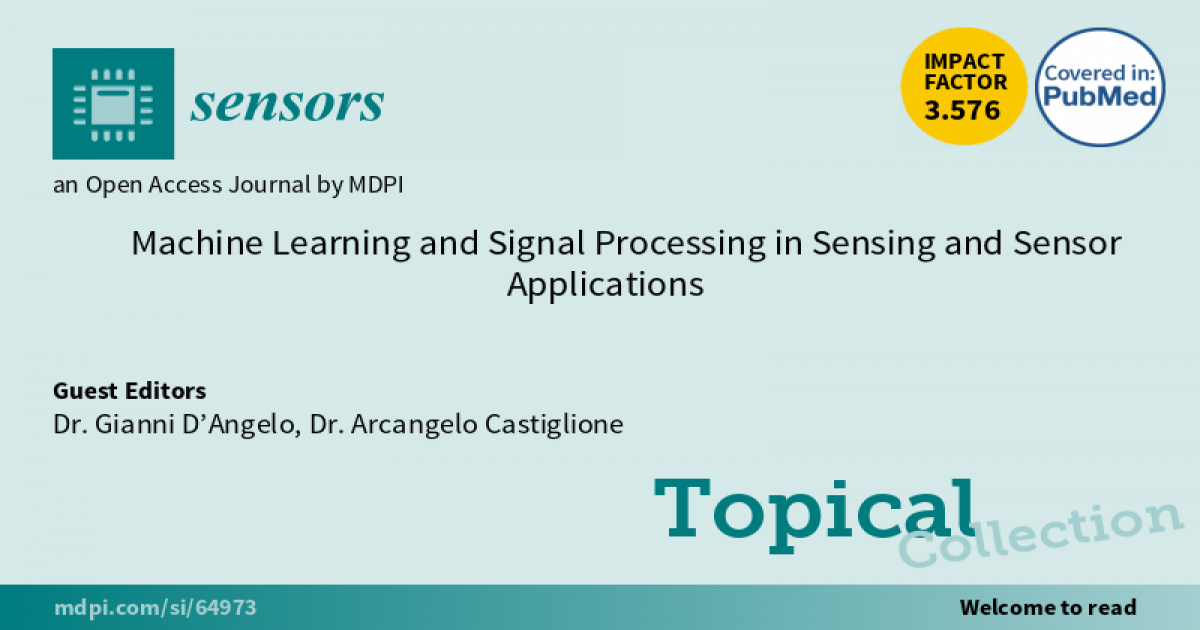- 3.5Impact Factor
- 8.2CiteScore
- 20 daysTime to First Decision
Machine Learning and Signal Processing in Sensing and Sensor Applications
This special issue belongs to the section “Sensing and Imaging“.
Special Issue Information
Dear Colleagues,
In recent decades, machine learning (ML) technologies have made it possible to collect, analyze, and interpret a large amount of sensory information. As a result, a new era of intelligent sensors is emerging that changes the ways of perceiving and understanding the world. The integration of ML algorithms with artificial intelligence (AI) technology benefits other areas such as Industry 4.0, Internet of Things, etc. leveraging these two technologies, it is possible to design sensors tailored to specific applications. To this end, signal data, such as electrical signals, vibrations, sounds, accelerometer signals, as well as any other kind of sensory data like images, numerical data, etc. need to be analyzed and processed from real-time algorithms to mine useful insights and to embed these algorithms in sensors.
This Special Issue calls for innovative work that explores new frontiers and challenges in the field of applying ML/AI technologies and algorithms for high-sample-rate sensors. It includes new ML and AI models, hybrid systems, as well as case studies or reviews of the state-of-the-art.
The topics of interest include, but are not limited to the following:
- ML algorithms in smart sensor systems
- AI models in smart sensor systems
- ML/AI‐enabled smart sensor systems
- Practical smart-sensor applications
- Practical smart-sensing systems
- Health and disease data management
- Medical image diagnosis and analysis
- Biology data analysis
- Smart visual imaging sensing systems
- Object detection and recognition
- Smart-sensors for environmental pollution management
- Smart-sensors for precision agriculture and food science
- Big data analytics for sensor data
- Intelligent real-time algorithms for sensor data
- Features for signal classification
- Feature discovery
- Applications of AI and ML in sensor domains: energy, IoT, Industry 4.0, etc.
Dr. Gianni D’Angelo
Collection Editor
Manuscript Submission Information
Manuscripts should be submitted online at www.mdpi.com by registering and logging in to this website. Once you are registered, click here to go to the submission form. Manuscripts can be submitted until the deadline. All submissions that pass pre-check are peer-reviewed. Accepted papers will be published continuously in the journal (as soon as accepted) and will be listed together on the special issue website. Research articles, review articles as well as short communications are invited. For planned papers, a title and short abstract (about 250 words) can be sent to the Editorial Office for assessment.
Submitted manuscripts should not have been published previously, nor be under consideration for publication elsewhere (except conference proceedings papers). All manuscripts are thoroughly refereed through a single-blind peer-review process. A guide for authors and other relevant information for submission of manuscripts is available on the Instructions for Authors page. Sensors is an international peer-reviewed open access semimonthly journal published by MDPI.
Please visit the Instructions for Authors page before submitting a manuscript. The Article Processing Charge (APC) for publication in this open access journal is 2600 CHF (Swiss Francs). Submitted papers should be well formatted and use good English. Authors may use MDPI's English editing service prior to publication or during author revisions.

Benefits of Publishing in a Special Issue
- Ease of navigation: Grouping papers by topic helps scholars navigate broad scope journals more efficiently.
- Greater discoverability: Special Issues support the reach and impact of scientific research. Articles in Special Issues are more discoverable and cited more frequently.
- Expansion of research network: Special Issues facilitate connections among authors, fostering scientific collaborations.
- External promotion: Articles in Special Issues are often promoted through the journal's social media, increasing their visibility.
- e-Book format: Special Issues with more than 10 articles can be published as dedicated e-books, ensuring wide and rapid dissemination.

